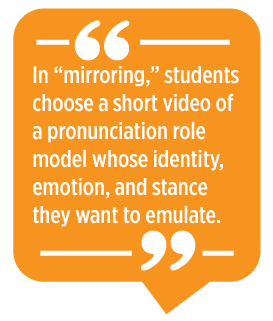Improving Students' English Pronunciation With Video Role Models
by Darren K. LaScotte and Elaine Tarone
 Second language acquisition research tells us that
social factors—such as a speaker’s audience, identity, emotion, and stance—influence
the pronunciation of a second language and impact intelligibility. That is,
speakers make themselves more or less easy to understand based on the social
situation and context they find themselves in. For teachers, this may not seem
like new information. We are well aware that our students’ demonstrated
proficiency levels in language skills can shift across various tasks and lesson
units. We are also increasingly aware of the need to center social context in
our lessons, as different situational factors will call for different language
forms to carry out specific language functions (e.g., WIDA, 2020).
Second language acquisition research tells us that
social factors—such as a speaker’s audience, identity, emotion, and stance—influence
the pronunciation of a second language and impact intelligibility. That is,
speakers make themselves more or less easy to understand based on the social
situation and context they find themselves in. For teachers, this may not seem
like new information. We are well aware that our students’ demonstrated
proficiency levels in language skills can shift across various tasks and lesson
units. We are also increasingly aware of the need to center social context in
our lessons, as different situational factors will call for different language
forms to carry out specific language functions (e.g., WIDA, 2020).
Unfortunately, however, it seems that many of the
available commercial textbooks that teach pronunciation to students continue to
use a decontextualized and rule-based approach, which starts with individual
sounds and phonemes and describes rules for how to combine them to form larger
units, much like the way that grammar textbooks describe and teach syntax. In
such teaching materials, social context appears to be an afterthought, as very
little is usually said about the importance of real-world social and pragmatic
factors that can affect intelligibility.
An Innovative Approach to Teaching Pronunciation
In this article, we offer a different approach to
teaching pronunciation called the Mirroring Project, which can complement and
expand upon more traditional methods and materials that teachers may already be
using in their classrooms. Unlike other more traditional approaches, the
Mirroring Project starts with social context and focuses squarely on students’
selection and reenactment of the voices of video-recorded speakers—whom we refer
to as students’ pronunciation role models.
 In “mirroring,” students choose a short video of a
pronunciation role model whose identity, emotion, and stance they want to
emulate, and they practice reproducing the words and movements of that role
model, word for word and gesture for gesture—akin to a mirror image. Later,
they try to “channel” their role model’s pronunciation patterns and body
movements to deliver their own ideas as they record original interactive
presentations in front of the class. (To view video-recorded presentations of
two learners before and after their Mirroring Project, see LaScotte
et al., 2020).
In “mirroring,” students choose a short video of a
pronunciation role model whose identity, emotion, and stance they want to
emulate, and they practice reproducing the words and movements of that role
model, word for word and gesture for gesture—akin to a mirror image. Later,
they try to “channel” their role model’s pronunciation patterns and body
movements to deliver their own ideas as they record original interactive
presentations in front of the class. (To view video-recorded presentations of
two learners before and after their Mirroring Project, see LaScotte
et al., 2020).
The Mirroring Project was originally designed with
international teaching assistants in mind to help them prepare for rehearsed
presentations and university lectures (Lindgren et al., 2003; Meyers, 2013),
but has since been expanded to include students in intensive English programs
as well (LaScotte & Tarone, 2022). Here we briefly outline the
Mirroring Project in 10 easy steps, and we invite practicing teachers—in
whatever teaching context(s) they find themselves—to try out this activity in
their own classrooms.
The Mirroring Project in 10 Steps
Step 1: Identify Pronunciation
Challenges
The first step is to have your students undertake
some type of diagnostic, such as giving a self-introduction or a short speech
about a topic of interest. Record this diagnostic and then analyze it together
with students to identify each individual’s unique areas for improvement (e.g.,
use of pausing, rate of speech, pitch range, or gestures).
Step 2: Select a Role Model
Based on the diagnostic, ask each student to choose
a pronunciation role model who is both exemplary in the areas that were
identified as needing improvement (in Step 1) and someone the student
identifies with. Once students have their role models, they select a short
video-recorded speech segment (1–2 minutes) for analysis. Teachers can help to
guide them to consider segments that are a good fit.
Step 3: Analyze for Purpose and Tone
Students analyze the purpose and tone of the video
segment, and the ways in which verbals (e.g., volume, rate of speech, pausing,
intonation) and nonverbals (e.g., gestures, facial expressions) contribute to
that purpose and tone. For example, if the model is angry or distraught and is
trying to persuade their audience to do something, what verbal and nonverbal
elements help communicate this?
Step 4: Analyze for Verbal and
Nonverbal Characteristics
During this step, students should transcribe the
segment (or download a transcription, if available). Then, students analyze the
segment for the features of pronunciation and nonverbals they are working on.
Step 5: Mirror the Model, Frame by
Frame
Next, students focus on putting each short phrase
(or thought group) into their short-term memory by watching their video,
pausing after each phrase or sentence, then saying that phrase or sentence
immediately afterward, mirroring the exact words and body language of the
model.
Step 6: Memorize the
Segment
Now, students are ready to memorize the entire
speech segment and make it their own. Have students use their marked transcript
and practice reading each thought group, looking up, and saying it to a partner
or small group.
Step 7: Record a Trial Version
Each student comes to the front of the room and
performs the segment just as in Step 6, but now they have a larger audience
consisting of their classmates and the teacher. Video-record each student’s
trial version, then ask the audience to give them feedback.
Step 8: Critique the Trial Version
After class, students watch their trial versions
and complete a self-critique in which they identify their own strengths and
challenges. They can analyze aspects of their pronunciation and how effectively
they captured the emotions and tone of the model. The instructor can also
provide feedback on students’ strengths and challenges.
Step 9: Record and Critique a Final
Version
For the final version of mirroring, each student
again records their performance of the segment. However, this time they are
expected to have memorized it so that they do not need the transcript. If
desired, they can bring in props or even dress like the original model. After
viewing their final recording, students complete a self-critique, focused this
time on ways the final version improved compared to their trial version.
Step 10: Channel the Model
Speaker
It is clearly not enough to simply mirror the exact
words of a role model; a learner must transfer the model’s “voice”
(pronunciation and nonverbal patterns), using it in the delivery of their own
ideas. In Step 10, students perform (in front of an audience) an original presentation, such as a self-introduction or a
written speech, while trying to channel the voice of their model speaker. Video-record
this presentation for use in a final evaluation and self-critique. Teachers can
help students to analyze their performance in Step 10, noticing areas where
they have improved since completing Step 1. Students can also set future goals
for continued pronunciation improvement.
Conclusion
We encourage readers to try out the Mirroring
Project with their own students, and we hope they will enjoy and benefit from
using this approach as much as we have. We also hope they will share their
innovations, successes, problems, and solutions with colleagues in professional
venues. In our experience, this approach has worked best in combination with a
more decontextualized analysis of pronunciation from a traditional textbook. In
other words, we are not saying teachers should only
use the Mirroring Project and do away with their analytical pronunciation
lessons. Instead, students can use that analysis to develop voices that
effectively and intelligibly communicate their identities in social
interaction.
Interested readers can find more information about
the research that supports this and other top-down approaches to pronunciation
teaching, as well as ready-to-use student worksheets for Steps 1–10 of the
Mirroring Project, in our latest book, Voice
and Mirroring in L2 Pronunciation Instruction (LaScotte et
al., 2023).
References
LaScotte, D., Meyers, C., & Tarone, E.
(2020, November). Voice and mirroring in SLA: Top-down pedagogy for
L2 pronunciation instruction [Conference presentation]. 2020
Minnesota English Learner Education Conference. https://www.youtube.com/watch?v=DqNyk0mEhP0&t
LaScotte, D., Meyers, C., & Tarone, E.
(2023). Voice and mirroring in L2 pronunciation
instruction. Equinox.
LaScotte, D., & Tarone, E. (2022).
Channeling “voices” to improve L2 English intelligibility. The Modern
Language Journal, 106(4), 744–763. https://doi.org/10.1111/modl.12812
Lindgren, J., Meyers, C., & Monk, M.
(2003). Approaches to accent: The Mirroring Project
[Conference presentation]. TESOL 2003 International Convention &
English Language Expo, Baltimore, MD, United States.
Meyers, C. (2013). Mirroring project update:
Intelligible accented speakers as pronunciation models. TESOL Video
News. /tesolvdmis/issues/2013-07-27/6.html
WIDA. (2020). WIDA English language
development standards framework, 2020 edition: Kindergarten–grade
12. Board of Regents of the University of Wisconsin
System.
Darren K.
LaScotte, PhD, is a teaching specialist in
the Minnesota English Language Program at the University of Minnesota, where he
teaches English as a second language to international students. Over the last
decade, his scholarship has focused on second language acquisition and use and
on the resulting implications for teaching and learning. He is a corecipient of
the 2023 TESOL Award for Excellence in Research (with Elaine
Tarone).
Elaine
Tarone, PhD, is distinguished teaching
professor emerita and retired director of the Center for Advanced Research on
Language Acquisition at the University of Minnesota. A recipient of the
American Association for Applied Linguistics Distinguished Scholarship and
Service Award in 2012, her research focuses on second language acquisition in
social context. She is a corecipient of the 2023 TESOL Award for Excellence in
Research (with Darren K. LaScotte).